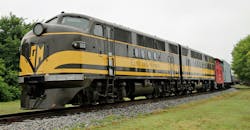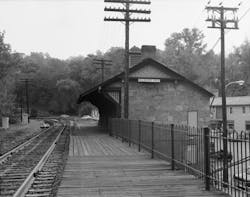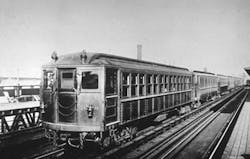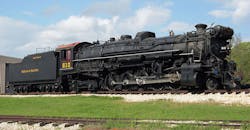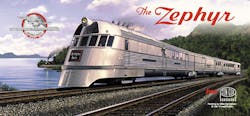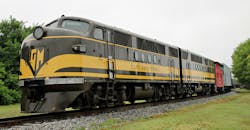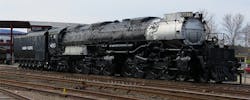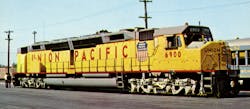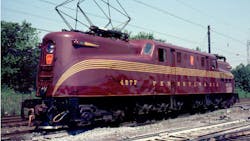11 Railway Engineering Marvels
Baltimore & Ohio Railroad: Old Main Line
The first public service (common carrier) railroad, the Old Main Line, was started in 1828 and constructed over two years. Operating between Baltimore and Harper’s Ferry W.V., it was the world’s longest railway at 60 miles. Prior to all that, railroads were private and carried cargo only for the train’s owner. It was also the first to carry passengers in the U.S. and the first to have been built with a mission in mind: opening the interior of the U.S. Other B&O firsts include T-rail sections, conical wheels, high-pressure steam engines, and iron wheels on passenger cars.
By 1857, the railway stretched to St Louis. By 1874, it extended into Chicago, and by 1886 it went up the east coast to Philadelphia and New York City. By 1952, it included 6,000 miles of track, 2,000 locomotives, and 100,000 passenger and cargo cars. (The image is of Ellicott City Station, the oldest surviving passenger station in the U.S. and built In 1830 on the Old Main Line)
Shay’s Geared Locomotives
Up until about 1890, locomotives were of the rod type, with pistons or rods pumping in and out of steam cylinders to move the large traction wheels. But they didn’t have the traction and durability needed to move cargo over the rough and temporary tracks common in the mining and lumber industries of the day. That’s where Ephraim Shay came in. He designed a locomotive that used a high-speed steam engine, sending geared-down power to axles on four-wheeled trucks. This made them ideal for slow and heavy hauling on mountains and rough grades. Shay locomotives were built in Lima, Ohio beginning in 1912. And a lot of them were built, too—some 2,761. There were two variants: the Heislers, which predate Shay by 13 years (and are famous for burning sawdust waste from the mill they serviced); and the Climaxes, which were first built in 1888..
Shay locomotives pulled heavy loads over difficult terrain until 1960, when they were replaced by trucks and highways.
Interborough Rapid Transit
New York City erected the first of it elevated trains in 1868, but the bustling metropolis didn’t really have the room above ground for all the tracks and lines it needed. So in 1900, construction began on the Interborough Rapid Transit, better known as the New York subway. When it opened in 1904, it ran 9.1 miles from City Hall to 145th Street and Broadway (the fare was a nickel). By 1905 it extended to the Bronx, and by 1908 it went to Brooklyn, completing the first subway line. Building the underground tracks through the subsurface crowded with sewer pipes, water and gas mains, and conduits for power and telegraph lines was a major challenge. To overcome them, the contractors developed cut-and-cover excavation, subaqueous shields, advances in rock tunneling, and steel-bent construction.
In 1940, the IRT was bought by the City of New York. Today, it has a fleet of more than 7,000 cars making 8,000 trips every day.
Pullman Cars
George Pullman began building and operating sleeper, lounge, and parlor cars for trains beginning in 1859. His company continued upgrading and improving his designs, becoming the first to offer enclosed vestibules, diaphragms between rail cars, Westinghouse air brakes, Janney knuckle couplers, steam heating, and electric lighting. By 1910, the Pullman Co. came up with a design, called the Carnegie, which became the standard Pullman car for two decades. (Pullman himself died in 1897.) Standardizing let Pullman improve reliability, strength, and safety and lower costs. At the height of the company’s popularity in 1925, it operated 9,800 cars and employed 28,000 conductors and 12,000 porters.
Lima Superpower Steam Locomotive
The “superpower” locomotives designed and built at the Lima Locomotive Works from 1925 to 1949 combined a high-capacity boiler with modern valve gears and a four-wheel trailing truck (usually unpowered wheels behind the driving wheels). Most American steam locomotives that came later took their engineering cues from these. The image shows #610, the sole surviving example. It had slightly higher boiler pressure, 255 psig rather than 250. This gave it a tractive force of 84,6000 lb and 13,300 lb for the booster, an extra engine that supplied the trailing truck wheels with traction for starting off or climbing difficult grades. The locomotive weighed 452,000 lb and had an adhesive weight of 300,000 lb. (Adhesive weight is the weight on the driving wheels of a locomotive. It determines the frictional grip between wheels and rail, and the drawbar pull a locomotive exerts). The tender carried 5,000 gallons of oil, the fuel, and 14,000 of water for the steam engine. (Photo by Renelibrary)
Pioneer Zephyr
The Pioneer Zephyr was the first diesel-powered stainless-steel streamlined train. It speed and luxurious passenger cars revitalized both cargo and passenger travel by train—markets that were going to cars and trucks and federally-built highways. It had a two-stroke, eight cylinder in-line diesel that could crank out 600 hp. It powered a 600-V dc motor that kept the traction motors turning. The locomotive could travel at up to 110 mph, four times as fast as most steam locomotives. This was the beginning of the end of the Steam Era. In 1934, the year of the Zephyr’s initial run, 50,000 steam locomotives were racking up 17.8 billion passenger-miles and 268 billion cargo-miles. Twenty-seven years later, 28,500 diesel locomotives were producing 20 billion passenger-miles and 565 billion cargo-miles. Diesel’s advantages and capabilities had won out. In the Zephyr’s 26-year career, it travelled 3.2 million miles.
EMD-10-3 Diesel Electric Locomotive
When Chief Engineer Richard Dilworth, a former Navy electrician, and his team at the Electro-Motive Div. of GM Corp. designed the EMD-103 locomotive in 1939, they couldn’t know it would become the prototype for almost 20 years of diesel-electric trains. It was a blunt-nosed 193-ft long, 900,000 lb freight locomotive capable of generating 5,400 hp. It used a 16-cylinder diesel motor and rode on two four-wheel trucks with all axles powered. One of its advantages was that the motor was relatively smokeless. Some tunnels, such as the 6.2-mile Moffat Tunnel in Colorado, were so long that the smoke cloud surrounding a hard-puffing steam-powered train was enough to suffocate livestock.
Union Pacific’s Big Boys
Some of the largest, most powerful locomotives ever built were the Big Boys of Union Pacific. That railroad moved heavy loads of ore and freight over the Wasatch Mountains, and often needed to add more locomotives or split loads to get them over the terrain. The UP wanted a single locomotive that could do the job and save the expense and time of hooking up and unhooking the extra engines. The first, the 4000 class coal-powered steam locomotive, was an 85-ft long articulated train built by the American Locomotive Co. It could carry a full load safely at 80 mph. Peak horsepower (6,290 HP) came at about 35 mph, and peak traction at 10 mph. The articulation let the front portion of the chassis containing the first pair of wheels swivel left or right a bit, reducing friction and binding on tight turns. The company built 25 for the UP. They operated from 1941 through 1959.
In 1969, UP began purchasing 47 DDA40X, a fleet of diesel-powered Big Boys. Each used twin V-16 turbo-charged diesel engines and generated 6,600 hp. In the early 1980s , excessive maintenance forced UP to mothball its 45 remaining units. Then in 1984, rail traffic rebounded, and 25 were rebuilt and put back in service. By the middle of next year, they were all retired again—except one, which mostly handles excursion trips.
GG1 Electric Locomotive
The GG1 was designed by the Pennsylvania Railroad. Built by the Baldwin Locomotive works for electrified train lines, it was prevalent on the East coast. The GG1 drew power from an overhead catenary and could travel at over 120 mph. The train featured a newly developed dual-tripod suspension that ensured the load was equal on all the driving wheels, regardless of the track condition or curvature. The locomotive was also symmetrical, with crew cabs on each, letting the GG1 run in either direction without having to turn it around (a time-consuming maneuver). 139 were built from 1943 to 1953, and some continued working for 44 years. They served longer in front-line duty than any other locomotive—steam, diesel, or electric.
Cab-in-Front Steam Locomotive
Southern Pacific was the only railroad to use this type of locomotive, which was one of the longest, heaviest, and most powerful in 1944. It was 125.5 ft long, weighed more than a million pounds, and put out 6,000 hp, which it could turn into 124,3300 lb of tractive force. Putting the cab in front meant the crew had fresh air, less heat, and better visibility than steam-powered trains with cabs in the back.
Tokaido Shinkansen: The First Bullet Train
The bullet train began running from Tokyo to Shin-Oska in Japan in 1964 with the 000 Series of locomotives (shown). That series remain operational though 2000. There are seven other series. The train draws power from a 25 kV ac overhead line and each axle is driven by a 185 kW traction motor. Initially, the electric train travelled at up to 130 mph. Speeds are now up to 177 mph. By 1992, the line was carrying an average of 600,000 passengers per day. At present, it has carried more than 5.3 billion passengers.
